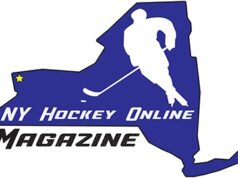By Greg Bates —
Chair of USA Hockey’s Disabled Section has helped grow all levels and disciplines of disabled hockey
J.J. O’Connor still remembers how awkward he felt in that first meeting.
It was June 2002, and the 23-year-old had just been elected the chair of the Disabled Section for USA Hockey.
“The funny thing was that they were looking for somebody to run the section and to be a good fit, but I had no clue what I was doing,” O’Connor said. “Here I am 23 years old and I’ve been asked to lead this group — I was the youngest board member ever. The large majority of the people around me were significantly older than I was. Now I look to be in a leadership role and I’m just a kid.”
O’Connor left the meeting and talked to his friend Jim Smith, who had recommended O’Connor become the Disabled Section chair. Smith, who is now the president of USA Hockey, had a few words of advice for the youngster, including, “Don’t worry, you’ll learn.”
O’Connor in fact learned on the fly. Now, 18 years later, his impact as a volunteer for USA Hockey has been almost immeasurable.
J.J. poses with the O’Connor Courage Trophy, which is awarded each year to the Tier I champion at the USA Hockey Sled Classic.
“We were looking for someone who knew the game of ice hockey, could communicate and relate positively to those with disabilities and who had the leadership skills to take this portion of our game to heights it had never reached previously,” said Smith about O’Connor. “J.J. was a natural fit to take over the Disabled Section.”
O’Connor was a natural fit because he knew and loved the game despite a tragic on-ice accident that led to him being paralyzed.
A Chicago native, O’Connor attended Loyola Academy in Wilmette, Illinois, and as a 16-year-old, he played for the Chicago Patriots. He was hoping to play for his high school team or the Skokie Flyers, but due to missing tryouts for a couple unforeseen reasons, O’Connor stuck with the Patriots.
“The funny thing about it was there was almost like this message out there in the universe that maybe this season I should sit it out,” O’Connor said. “But I was obviously in love with the game and persistent and decided to play with the Patriots anyway.”
The first game of the season, Oct. 24, 1995, the Patriots were playing their rival Flyers, the team O’Connor was hoping to skate for. The roster was filled with his friends. O’Connor was going to do anything to pull off the upset against the defending state champions.
“My first shift, one of my teammates just over the red line dumped it in and I’m the first forward in [with] the defenseman on the other team,” O’Connor said. “He was my closest friend from that team — we hung out lots outside of hockey in general. There was no ill will, so we were just both chasing after the puck and it was just the exact reason why the NHL and everybody’s changed from touch icing because two players going full speed for a puck on the boards. As we both approached the puck to touch it and play the puck, we just tripped on each other. We both just got tangled up. We both fell — he had his feet go out from under him and I fell face first.”
O’Connor crashed into the boards, suffered a C4 spinal cord injury and was immediately a quadriplegic. He went on to graduate from Loyola Academy and attended Lake Forest College. Just one year after graduation, O’Connor found his purpose in life through USA Hockey.
Now at 41, O’Connor is still going strong in his position. When he took over the Disabled Section, there were four disciplines: sled, special hockey, deaf/hard of hearing and standing/amputee. Every discipline was in its infancy and relatively unknown.
“I wanted it to be known,” said O’Connor, who lives in Mount Prospect, Illinois. “I don’t know if recognition is the right word for the section, maybe awareness of the section. I wanted to put on the map so people would know about it and disabled athletes would be known for the adversities that they overcome and yet still are hockey players just like everybody else.”
In the last four years, two more disciplines were added to the disabled section: warrior hockey and blind/visually impaired. O’Connor played a big role in the creation of those two disciplines.
Every discipline is excelling, but sled hockey has reached insurmountable heights. The U.S. Paralympic Sled Hockey Team has captured gold in four of the last five Paralympic Winter Games, including the last three in a row.
| DISABLED DISCIPLINES |
“We’ve dominated on the international side in sled hockey in the time that I’ve been chair, so I can’t help but be proud of that,” O’Connor said. “I believe our successes are great. I feel like we’ve come a long way in 18 years.”
Smith cited helping turn the U.S. sled team into the top program in the world as O’Connor’s biggest accomplishment to date.
“J.J.’s vision to help create the USA Sled Lending Program so organizations can conduct learn-to-play sled hockey clinics around the country and the distribution of funding through the sled lending grants has brought more sled players into our game than any other country in the world,” Smith said.
“While our sled players are extremely talented and our staffs have been phenomenal, the vision for all of these sled programs enacted under J.J.’s leadership and guidance is one of the main reasons we have been the most dominant national sled team in the world over the past 15 years.”
Another feather in the cap for O’Connor was the formation and success of the Disabled Hockey Festival. It’s the largest indoor event USA Hockey puts on every year. In 2019, 155 teams with over 2,600 players and coaches participated over two weekends.
Even though during the Disabled Hockey Festival is a hectic time, O’Connor makes sure he takes a step back to take in the magnitude of the event.
| DISABLED FESTIVAL |
“It sinks in more often than one would think,” O’Connor said. “I still run a sled hockey team locally and a week before everything shut down for the virus at the end of the season, I had a 14-year-old boy who’s going through chemo treatments and trying to beat cancer and he came out and tried sled hockey for the first time. The smile on the kid’s face, it never gets old. He couldn’t wait to come back and he couldn’t wait to get done with chemo so he could be a full-fledged member of the team. It’s those moments that you stand back and you think, ‘Wow. We did a good job here.’”
When O’Connor dealt with his life-altering injury at 16, he hoped to turn his tragic accident into a positive down the line.
“I’m feeling like I did what I set out to do,” O’Connor said. “I wanted to make the world a better place, the Disabled Section a better place than when I got it, and I feel like I’ve been able to do that. I’ve been able to give back to the game I love. I’ve been able to give back to the game that’s meant so much to me.”
Story from Red Line Editorial, Inc.







